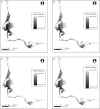Environmental niche divergence among three dune shrub sister species with parapatric distributions
- PMID: 28334085
- PMCID: PMC5604598
- DOI: 10.1093/aob/mcx004
Environmental niche divergence among three dune shrub sister species with parapatric distributions
Abstract
Background and aims: The geographical distributions of species are constrained by their ecological requirements. The aim of this work was to analyse the effects of environmental conditions, historical events and biogeographical constraints on the diversification of the three species of the western Mediterranean shrub genus Stauracanthus , which have a parapatric distribution in the Iberian Peninsula.
Methods: Ecological niche factor analysis and generalized linear models were used to measure the response of all Stauracanthus species to the environmental gradients and map their potential distributions in the Iberian Peninsula. The bioclimatic niche overlap between the three species was determined by using Schoener's index. The genetic differentiation of the Iberian and northern African populations of Stauracanthus species was characterized with GenalEx. The effects on genetic distances of the most important environmental drivers were assessed through Mantel tests and non-metric multidimensional scaling.
Key results: The three Stauracanthus species show remarkably similar responses to climatic conditions. This supports the idea that all members of this recently diversified clade retain common adaptations to climate and consequently high levels of climatic niche overlap. This contrasts with the diverse edaphic requirements of Stauracanthus species. The populations of the S. genistoides-spectabilis clade grow on Miocene and Pliocene fine-textured sedimentary soils, whereas S. boivinii , the more genetically distant species, occurs on older and more coarse-textured sedimentary substrates. These patterns of diversification are largely consistent with a stochastic process of geographical range expansion and fragmentation coupled with niche evolution in the context of spatially complex environmental fluctuations.
Conclusions: : The combined analysis of the distribution, realized environmental niche and phylogeographical relationships of parapatric species proposed in this work allows integration of the biogeographical, ecological and evolutionary processes driving the evolution of species adaptations and how they determine their current geographical ranges.
Keywords: Biogeography; Messinian salinity crisis; Stauracanthus; diversification; ecological niche factor analysis (ENFA); niche overlap; phylogeography; species distribution modelling.
© The Author 2017. Published by Oxford University Press on behalf of the Annals of Botany Company. All rights reserved. For Permissions, please email: journals.permissions@oup.com
Figures





Similar articles
-
Genetic variation and phylogeography of Stauracanthus (Fabaceae, Genisteae) from the Iberian Peninsula and northern Morocco assessed by chloroplast microsatellite (cpSSR) markers.Am J Bot. 2008 Jan;95(1):98-109. doi: 10.3732/ajb.95.1.98. Am J Bot. 2008. PMID: 21632320
-
Widespread correlations between climatic niche evolution and species diversification in birds.J Anim Ecol. 2016 Jul;85(4):869-78. doi: 10.1111/1365-2656.12530. Epub 2016 May 12. J Anim Ecol. 2016. PMID: 27064436
-
Diversification in North American arid lands: niche conservatism, divergence and expansion of habitat explain speciation in the genus Ephedra.Mol Phylogenet Evol. 2012 Nov;65(2):437-50. doi: 10.1016/j.ympev.2012.06.025. Epub 2012 Jul 7. Mol Phylogenet Evol. 2012. PMID: 22776548
-
Hutchinson's duality: the once and future niche.Proc Natl Acad Sci U S A. 2009 Nov 17;106 Suppl 2(Suppl 2):19651-8. doi: 10.1073/pnas.0901650106. Epub 2009 Sep 18. Proc Natl Acad Sci U S A. 2009. PMID: 19805163 Free PMC article. Review.
-
Persistence and stochasticity are key determinants of genetic diversity in plants associated with banded iron formation inselbergs.Biol Rev Camb Philos Soc. 2019 Jun;94(3):753-772. doi: 10.1111/brv.12477. Epub 2018 Nov 26. Biol Rev Camb Philos Soc. 2019. PMID: 30479069 Review.
Cited by
-
Westwards and northwards dispersal of Triosteum himalayanum (Caprifoliaceae) from the Hengduan Mountains region based on chloroplast DNA phylogeography.PeerJ. 2018 May 11;6:e4748. doi: 10.7717/peerj.4748. eCollection 2018. PeerJ. 2018. PMID: 29770273 Free PMC article.
-
Climatic and edaphic niche shifts during plant radiation in the Mediterranean biodiversity hotspot.Ann Bot. 2025 Mar 13;135(4):717-734. doi: 10.1093/aob/mcae205. Ann Bot. 2025. PMID: 39673382
-
Dynamics of post fire plant community assembly in Doñana coastal dunes.Sci Rep. 2025 Jun 6;15(1):19935. doi: 10.1038/s41598-025-04400-x. Sci Rep. 2025. PMID: 40481079 Free PMC article.
-
Biogeography and environmental preferences of Butia yatay (Mart.) Becc.Ecol Evol. 2023 Nov 27;13(11):e10749. doi: 10.1002/ece3.10749. eCollection 2023 Nov. Ecol Evol. 2023. PMID: 38034334 Free PMC article.
-
Biomod2 modeling for predicting the potential ecological distribution of three Fritillaria species under climate change.Sci Rep. 2023 Nov 1;13(1):18801. doi: 10.1038/s41598-023-45887-6. Sci Rep. 2023. PMID: 37914761 Free PMC article.
References
-
- AEMET-IM. 2011. Iberian climate atlas. Madrid: AEMET-IM.
-
- APA. 1992. Atlas do ambiente. Lisbon: Agência Portuguesa do Ambiente.
-
- Barbero M, Quezel P.. 1982. Classifying Mediterranean ecosystems in the Mediterranean rim countries and in southwestern U.S.A. General Technical Report PSW-58. Berkeley, USA: Pacific Southwest Forest and Range Experiment Station, USDA Forest Service.
-
- Barraclough Vogler. 2000. Detecting the geographical pattern of speciation from species-level phylogenies. American Naturalist 155: 419–434. - PubMed
MeSH terms
LinkOut - more resources
Full Text Sources
Other Literature Sources

